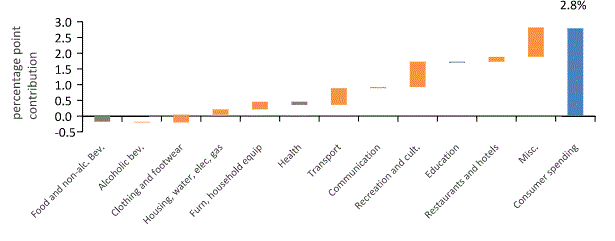Is the recovery in households' spending bypassing the retail sector?
Whilst the timing of an earlier Easter this year has made reading of retail sales more difficult this month, the latest set of data still offered encouraging signs that deflation in the high street and real income growth is supporting spending.
According to the ONS, retail sales showed robust growth in March as positive economic fundamentals continue to underpin spending and confidence. Year-on-year estimates of retail sales volumes showed growth for the 24th consecutive month in March 2015, increasing by 4.2 per cent compared with March 2014. This was the longest period of sustained year-on-year growth since May 2008 when there were 31 periods of growth.
The underlying pattern in the data as suggested by the three month on three month movement in the quantity bought continued to show growth for the 25th consecutive month, increasing by 0.9 per cent. This equals the longest period of sustained growth since November 2007 when there were also 25 periods of consecutive growth. However, growth has slowed sharply from the 12-year high of 2.0 per cent in the final quarter of 2014. Given the importance of consumer spending in the overall economy, we expect Q1 GDP to fall to around 0.4 per cent compared with 0.6 per cent in the previous quarter.
The BRC reported that like-for-like sales values rose by an annual 3.2 per cent in March, above our expectations, and the strongest increase since April last year distorted by the timing of Easter. Annual growth in total sales rose to 4.7 per cent from 1.7 per cent in the previous month. In real terms, given the BRCs Shop Price Index fell to a record low in March, volumes would have risen in the region of 6 per cent year-on-year.
In the long-term, we remain upbeat on the strength of retail sales as rising real incomes are expected to gather pace, the labour market strengthens and strong consumer confidence supports spending over the course of the year. We forecast consumer spending to rise at an annual rate of c.3.0-3.5 per cent in 2015.
However, the outcome of the General Election remains a key concern. The result of a hung parliament is likely to cause considerable uncertainty which will curtail business investment and could dent consumer confidence and spending. While a Labour-led coalition government could provide higher levels of disposable household income through-out the parliamentary term, based on deficit reduction plans, in the short-term, a prolonged period of uncertainty will be most damaging to the UK economy and confidence.
We are still confident that there is enough traction from the household sector to support healthy growth in consumer spending. However, there is growing concern that retail components of consumer spending are not benefiting as much as non-retail components. Figure 1 shows that the largest contribution to the growth of consumer spending is coming from transport, recreation and culture and miscellaneous inc. insurance and personal care products. Retailers should note that much of the additional boost to the consumer recovery so far has bypassed the retail sector. The latest data for consumer confidence showed a notable rise in March 2015. All five measures for consumer confidence increased with the overall measure reaching +4 - the highest for almost 13 years. The trajectory of consumer confidence can act as a useful forward looking indicator for the path of consumer spending. However, as we near the General Election, next months data will be telling as to whether consumers are becoming more nervous about the future.
Figure 1. Contribution to consumer spending by category - Q1 2015 forecast

Source ONS, Retail Economics analysis
Back to Retail Economic News